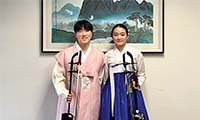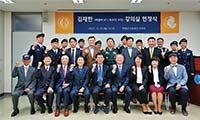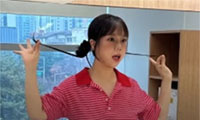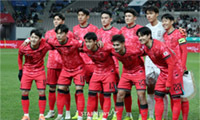Remember that forlorn figure of a Chinese youth on TV screen in a death-defying David-Goliath standoff, daring the rolling tanks at Beijing? blood-drenched Tiananmen Square?
The world stood still at that heart-stopping moment.
With the 10th anniversary of Sa-ee-gu looming ahead, I remember another lonely figure?hat UCLA student, a Korean grocer? son, who penned a heart-rending letter of protest to the Los Angeles Times at the height of the local media-fanned open season on hapless fellow immigrants.
? fear for my father? safety and well-being because of the way the media have
perpetuated the problem existing in South Central Los Angeles, Soo Hyun Lim wrote then-Editor Shelby Coffey, whose only paper in town was engaged in a marathon race-baiting, pitting one politically powerful but economically frustrated minority against a seemingly thriving tribe of non-English-speaking newcomers.
That was a year before LA Koreatown burned and choked through three days of firebombing, looting and mayhem, the mother of all riots in this land of freedom.
Soo Hyun Lim? happened to be the only letter from Korean Americans appearing in the Time? editorial page during the darkest hours of Korean American history, while their American-educated elites remained silent and aloof from the bedraggled hole-in-the-wall storekeepers under pogrom-like siege.
?y father is a Korean American merchant in South Central L.A. and as his son, I fear for his life every day. Both minority groups are trying hard to endure their cultural differences and are having a difficult time just surviving, Lim said.
?owever, the media consistently misrepresents how these groups exists
which in turn is pitting African Americans and Korean Americans against each other. Yet this friction is what both groups are trying so hard to overcome.
It? no accident Soo Hyun Lim is a product of UCLA, the longtime spawning ground for a steady stream of second-generation Korean American activists who returned home to fight on social and political action fronts, representing probably the most misperceived and maligned ethnic group in the country.
A decade later at a time when Sa-ee-gu is all but forgotten among today? Korean American youth the spirit of Soo Hyun Lim is very much alive among some children of Sa-ee-gu at his alma mater. Because of their baptism of fire in their adolescent years, latter-day Soon Hyun Lims are still haunted by their memories of the fiery siege and ever determined to work toward building bridges with Latino and African American neighbors.
This past fall at UCLA at least eight ?hildren of Sa-ee-gu enrolled in my course entitled Investigative Journalism: Exploring California? Subterranean PacRim Mosaic. It? an experimental class where students of all colors were required to forge interethnic teamwork in exploring cutting-edge issues (conflict and cooperation) affecting communities of color in LA? seething urbanscape and writing about their findings for the campus and community media.
Sa-ee-gu, I?e come to learn through their writings, has a lot to do with why these Korean-American students have chosen my annual course.
On that day of chaos and fires everywhere, design major Joyce Chon was in her sixth grade gym class in K-town when her father came to take her home.
?y heart quickened as I wondered what kind of emergency would cause my
dad to fish me out of school.
?hen we got home the doors and windows were immediately locked. The
television was ablaze with special reports, and the Korean radio was turned up even louder than usual for my parents to hear.
?y dad pulled out his hunting rifle and a box of bullets that I?e never seen before. He placed them both by the balcony window.
?he violence finally had gotten to Koreatown. That evening I saw a small
shopping center, located a block away, was engulfed in flames. I never saw a fire that big before. I was afraid it would reach us. No fire trucks came. In fact I heard no sirens of any kind at all.
(The next morning) I ventured outside with my parents. Taking those first steps outside my apartment was pretty scary. The sight of the charred empty lot was surreal. That building housed a Numero Uno Pizzeria that my mom and I would frequent. I got my haircuts from the beauty salons located on the second floor. All of it was gone.
?he area seemed strangely quiet. Everybody was stunned. Eventually the silence would break when small business owners came to see the damage. Some yelled, others wailed. I recognized one woman as the owner of the beauty salon. She used to cut my hair
? don? hear many people talk about the riots anymore. It was a pretty big marker in my life. .. I get angry, but I don? know at whom I should be angry. Should I be angry with the looters? They have no right to destroy other people? property. I could blame Korean merchants for treating their non-Korean customers badly. Then again, I could also be mad at the media for pitting the Koreans against blacks.
Joyce Chon sums up: ?ho? at fault and where are the solutions? Although I haven? sorted out my feelings, I do know one thing: the LA Riots ignited a fire inside me that I don? know how to put out.
Campus activist Theresa Kang was 13 and scared to death when riots erupted in South Central where her father owned a video store. ?ll I remember was that I hated it when my dad would go there in the heart of South Central during the riots, recalls Kang who serves as the vice president of the Korean Students Association. ?hile my dad? store didn? get ravaged or burned down, it led to a chain of events which would change my family? life.
?ooking back, I suppose it was all for the best. Before the riots I was your
typical little spoiled Korean girl, oblivious to what was going on. I shall never deny my family and what we have been through. I will also remember how my family went bankrupt, and how I refused to let my parents put the ?or sale sign on our front lawn. I will never forget how my father paced silently outside our home, distressed at having lost his grasp on his American Dream.
?or it is these very memories that I treasure. These struggles which I embrace. Though I am uncertain of what the future holds, I know I have been blessed; blessed to be Korean, blessed to be American, and certainly blessed to be a woman, bearer of life. And I know this final thing: I will never be tempted to dream of being someone else.
A few years older and perhaps a bit more knowledgeable, graduate student Susie Woo has been on a journey of redemption ever since that fateful day when her people witnessed their American Dream go up in smoke.
On Sa-ee-gu, then a freshman at UC-Irvine, ? lay in my dorm-room bed shivering and sick with the flu. The phone rang. Between sobs my mom asked me if I had seen the news. I told her I hadn?, as I reached over to turn on the TV.
? Latino male ran by with an armful of shoes and electronic equipment. An African American male teen, no older than 16, followed behind him and actually paused a moment to smile for the camera before running off with his stolen goods. Broken glass covered the sidewalks and flames licked at buildings as smoke billowed from windows.
? tried to calm my mom down. She begged me to call the news stations and go speak on behalf of all Koreans. ?ou America, she said, ?ou have responsibility to go on TV and look smart and say something for all Korean people.
? did not do anything.
? never realized how deeply this event would affect me. To this day I am still ashamed by inability to act. After all, my mother didn? expect me to save the world. She simply wanted me to take a stand for what she and my father believed to have been true when they immigrated to this country in 1969. They once had hope and faith in a just America.
?t was through my experiences working at the Los Angeles County Museum of Art that I was able to, in a very small way, make up for my previous shortcomings. Working with the diverse community of LA through various outreach programs ...I came to realize that the lack of communication among blacks, Asians, Latinos, and whites was at the root of the riots.
Susie Woo? goal is teaching at an inner-city high school or community college to open the lines of communication among young people of color so that they can move beyond the surface appearances to find the commonality that lies within.
?n the larger context of the 1992 riots, Susie Woo says, ?his may seem like a minuscule step towards rebuilding our community.
Amen to that. And God bless these children of Sa-ee-gu who haven? forgotten.
스마터리빙
more [ 건강]
[ 건강]이제 혈관 건강도 챙기자!
[현대해운]우리 눈에 보이지 않기 때문에 혈관 건강을 챙기는 것은 결코 쉽지 않은데요. 여러분은 혈관 건강을 유지하기 위해 어떤 노력을 하시나요?
 [ 건강]
[ 건강]내 몸이 건강해지는 과일궁합
 [ 라이프]
[ 라이프]벌레야 물럿거라! 천연 해충제 만들기
 [ 건강]
[ 건강]혈압 낮추는데 좋은 식품
[현대해운]혈관 건강은 주로 노화가 진행되면서 지켜야 할 문제라고 인식되어 왔습니다. 최근 생활 패턴과 식생활의 변화로 혈관의 노화 진행이 빨라지고
사람·사람들
more많이 본 기사
- 트럼프, 李대통령에 ‘백악관 황금열쇠’ 선물… “최고의 협력관계”
- 산타 한반도 다녀가셨네…성탄절 밤하늘 제주-서울 돌고 평양행
- 로비 단서 혹은 과대포장?…3천쪽 통일교 내부문건 살펴보니
- 백악관, 군에 “베네수엘라 원유 격리하라” 총력 지시
- 北 “신형장거리대공미사일 동해상 시험발사”…김정은 참관
- 국방부 “中, 美 안보 위협할 군사력 보유…본토 갈수록 취약”
- 조지아 역주행 사고, 한인 남편 이어 임신 아내·태아 사망
- ‘16kg 감량’ 홍현희, 다이어트 비결 뭐길래..날렵해진 턱 라인
- 성탄 전날 LA 일대 폭풍우…돌발 홍수·산사태 경보
- [‘로드 레이지’ 한인 피살 현장 상세 상황] 끼어들기 시비가 비극으로… 차에서 내려 “쏴봐라” 언쟁
- 경찰, ‘마약혐의’ 황하나 영장신청 예정…도피 중 범행도 수사
- “트럼프특사, 벨라루스 정상과의 협상수단으로 살빼는약 동원”
- [성탄절 문 여는 곳은] 코스코·월마트 닫고… CVS는 영업
- 테슬라 ‘비상시 차문 안열리는’ 문제… 1
- 한인 박찬영씨 총격살해범은 백인 군인...살해범 “박씨 차량이 끼어들어 시비가 붙어 결국 총쐈다”
- 엔비디아, ‘추론 강화 AI칩’ 스타트업과 기술 라이선스 계약
- 박나래, 과거 또 파묘..이번엔 ‘나혼산’ 18L 식용유 장면
- 한화 “필리조선소서 미군 핵잠 건조하기 위한 준비 착수”
- [미국은 지금] MAGA의 분열, 예… 3
- 함소원, 진화와 한 지붕 이혼 부부..결국 눈물 “헤어지는 게 힘들어”
- 기부 줄이는 미국인들…트럼프·고물가·탈종교 3중 한파
- 시애틀지역 사상최대 마약 적발...킹카운티 셰리프국, 메스암페타민 214파운드 압수
- 구은희 한국어교육재단 이사장 이천시 담당 부회장으로 임명
- [이민 단속] 여권 소지 시민권자들 … 2
- “올 한해 동안 너무 감사했어요”
- 워싱턴주 시애틀산악회 유철웅 회장 연임...2015ㆍ2016ㆍ2025년에 이어 4번째 회장직 맡기로
- “ATM기 사용하기 겁나네”
- 시택공항서 “내 이름이 뭔가요” 캠페인...가짜 차량공유 범죄 예방 위해 캠페인 시행키로
- 오레곤 한국전쟁기념재단 새 이사장에 박성민씨...새 부이사장에 김성윤씨…회장 및 사무총장은 유임키로
- [이민 단속] 새해에도 더 공격적 단속
- 법무부 “엡스타인 자료 100만건 추가돼…공개에 수주 소요”
- 팀 쿡 애플 CEO, 나이키 주식 43억원어치 매입…나이키 주가↑
- ‘소득세’없었던 워싱턴주에 소득세?...밥 퍼거슨 워싱턴주지사, ‘백만장자 소득세’ 공개 지지
- 이대우 뉴저지한인회장, “적자 개인적으로 전액변제”
- “최고의 산타” 아이유, ‘21세기 대군부인’ 현장에 통 큰 선물 쐈다
- 美, 물류거점창고에 불체자 8만명 수용 추진… ‘아마존택배’ 방식
- 역주행 승용차 덮쳐 한인 등 2명 사망
- 온라인쇼핑과 반품, 그리고 그 이후 1
- [남가주 6개 은행 전국 예금 현황] 1억달러 이상 예금고 지점 99개
- 먹는 비만약 경쟁 치열 ‘위고비’ 미국 판매승인
- 뉴욕증시, 성탄절 앞두고 상승 마감…S&P500 연일 사상최고치
- 대통령 상징 ‘봉황기’ 29일 0시 용산서 내리고 청와대에 걸린다
- 트럼프 행정부, H-1B비자 추첨 내년 2월 폐지…고임금 인력 우대
- [부 고] 박종군 전 뉴욕청과협회장 별세
- 두 손 모아 성탄기도… “온 세상에 평화를”
- 트럼프의 새 독트린 “미국을 다시 왜소하게”
- 지평 넓히는 K-푸드… 라면·김치 이어 과자·스낵 가세
- ‘올해는 ICE 이민자 체포 광풍의 해’
- 경찰, ‘통일교 로비 키맨’ UPF 前회장 13시간 피의자 조사
- ‘이정후 위엄’ SF CEO+사장+단장+감독→韓 총출동! 황재균·윌리 아다메스까지 선행 참여
1/5지식톡

-
 미 육군 사관학교 West Poin…
0
미 육군 사관학교 West Poin…
0https://youtu.be/SxD8cEhNV6Q연락처:wpkapca@gmail.comJohn Choi: 714-716-6414West Point 합격증을 받으셨나요?미 육군사관학교 West Point 학부모 모…
-
 ☝️해외에서도 가능한 한국어 선생님…
0
☝️해외에서도 가능한 한국어 선생님…
0이 영상 하나면 충분합니다!♥️상담신청문의♥️☝️ 문의 폭주로 '선착순 상담'만 진행합니다.☎️ : 02-6213-9094✨카카오톡ID : @GOODEDU77 (@골뱅이 꼭 붙여주셔야합니다…
-
 테슬라 자동차 시트커버 장착
0
테슬라 자동차 시트커버 장착
0테슬라 시트커버, 사놓고 아직 못 씌우셨죠?장착이 생각보다 쉽지 않습니다.20년 경력 전문가에게 맡기세요 — 깔끔하고 딱 맞게 장착해드립니다!장착비용:앞좌석: $40뒷좌석: $60앞·뒷좌석 …
-
 식당용 부탄가스
0
식당용 부탄가스
0식당용 부탄가스 홀세일 합니다 로스앤젤레스 다운타운 픽업 가능 안녕 하세요?강아지 & 고양이 모든 애완동물 / 반려동물 식품 & 모든 애완동물/반려동물 관련 제품들 전문적으로 홀세일/취급하는 회사 입니다 100% …
-
 ACSL 국제 컴퓨터 과학 대회, …
0
ACSL 국제 컴퓨터 과학 대회, …
0웹사이트 : www.eduspot.co.kr 카카오톡 상담하기 : https://pf.kakao.com/_BEQWxb블로그 : https://blog.naver.com/eduspotmain안녕하세요, 에듀스팟입니다…
케이타운 1번가
오피니언
 정숙희 논설위원
정숙희 논설위원온라인쇼핑과 반품, 그리고 그 이후
 파리드 자카리아 / 워싱턴포스트 칼럼니스트 / CNN ‘GPS’ 호스트
파리드 자카리아 / 워싱턴포스트 칼럼니스트 / CNN ‘GPS’ 호스트 트럼프의 새 독트린 “미국을 다시 왜소하게”
 김동찬 시민참여센터 대표
김동찬 시민참여센터 대표 [미국은 지금] MAGA의 분열, 예견된 균열의 시작
 임지영 (주)즐거운 예감 한점 갤러리 대표
임지영 (주)즐거운 예감 한점 갤러리 대표 [수요 에세이] 삶이라는 배를 타고
 이영창 / 한국일보 기자
이영창 / 한국일보 기자[지평선] ‘인간GPT’ 환각의 부작용
 조환동 / 편집기획국장·경제부장
조환동 / 편집기획국장·경제부장 AI로 가속화되는 노동시장 개편
 민경훈 논설위원
민경훈 논설위원‘크리스마스 캐롤’과 산타 클로스
 정재민 KAIST 문술미래전략 대학원 교수
정재민 KAIST 문술미래전략 대학원 교수 [정재민의 미디어풍경] 적과의 동침, 협력하며 경쟁하기
 김영화 수필가
김영화 수필가 [화요칼럼] 단호박의 온기
1/3지사별 뉴스

“온 세상에 평화를⋯”
숨가쁘게 달려온 2025년을 이제 1주일 남짓 남긴 채 크리스마스 이브를 맞는다. 다사다난했던 한 해를 되돌아보며 마무리하는 연말 시즌과 크리…
H-1B비자 고임금·경력자에 우선권

‘올해는 ICE 이민자 체포 광풍의 해’
올 한해동안 버지니아와 메릴랜드, DC 등에서 연방 이민당국에 체포된 사람이 1만명이 훌쩍 넘는 것으로 조사됐다. 또 미 전국적으로는 22만명…
“ATM기 사용하기 겁나네”

연말 ‘로드레이지’ 비극… 한인 총격 피살
연말을 맞아 도로 위에서 순간적으로 벌어진 운전 중 시비가 40대 한인 가장의 총격 피살 비극으로 이어졌다. 워싱턴주 레이시 경찰국과 서스턴 …
[‘로드 레이지’ 한인 피살 현장 상세 상황] 끼어들기 시비가 비극으로… 차에서 내려 “쏴봐라” 언쟁

오늘 하루 이 창 열지 않음 닫기 





















































.png)


댓글 안에 당신의 성숙함도 담아 주세요.
'오늘의 한마디'는 기사에 대하여 자신의 생각을 말하고 남의 생각을 들으며 서로 다양한 의견을 나누는 공간입니다. 그러나 간혹 불건전한 내용을 올리시는 분들이 계셔서 건전한 인터넷문화 정착을 위해 아래와 같은 운영원칙을 적용합니다.
자체 모니터링을 통해 아래에 해당하는 내용이 포함된 댓글이 발견되면 예고없이 삭제 조치를 하겠습니다.
불건전한 댓글을 올리거나, 이름에 비속어 및 상대방의 불쾌감을 주는 단어를 사용, 유명인 또는 특정 일반인을 사칭하는 경우 이용에 대한 차단 제재를 받을 수 있습니다. 차단될 경우, 일주일간 댓글을 달수 없게 됩니다.
명예훼손, 개인정보 유출, 욕설 등 법률에 위반되는 댓글은 관계 법령에 의거 민형사상 처벌을 받을 수 있으니 이용에 주의를 부탁드립니다.
Close
x